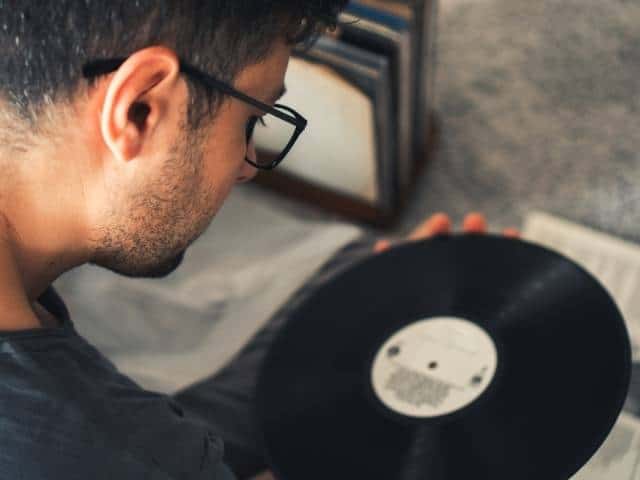Did you know that vinyl records sales surpassed both YouTube and Spotify’s revenues for the second year back in 2020? This is a paradox given the recent digitalization of music. That aside, I guess you probably heard some crackles or skips when playing your record recently and are wondering if you can fix a warped record.
You can often fix a warped record if you are patient and do it carefully. You can place the warped record between two large, heavy objects or sandwich it between sheets of glass and warm it in an oven with mild heat but too much heat can damage it further.
The rest of this article will explain the causes of record warping, how to tell if a record is warped, and the methods of fixing a warped record. Read on for detailed explanations of these aspects.
What Causes Vinyl Records To Get Warped?
Vinyl records get warped by several factors. Most of the causes of warping involve exerting excess pressure on records (usually from storing them incorrectly) or being exposed to heat.
The following are the common causes of record warping:
Exposure to Too Much Heat
You should protect your vinyl record collection from excessive heat. Attics and other unconditioned storage areas can reach high temperatures during the summer and vinyl records stored in these areas can suffer warping.
There are many cases of records getting warped after being left in parked cars for even less than an hour. According to this study, solar radiation can get trapped inside your car’s cabin. This leads to the accumulation of heat inside your vehicle, causing record warping.
Stacking the Records
Vinyl records are made of lightweight material. Therefore, excess pressure can damage them. Stacking your records is one of the causes of warping. When you do that, you exert more force on the ones at the bottom. This can cause cracking or produce scuff marks. To avoid that, you must always store records upright.
Cleaning the Record Using a Towel
Let’s consider this hypothetical situation: You spot some dust on your record, find the softest towel, and use it to wipe your vinyl. You have done the correct thing. Right? Wrong!
No matter how soft a piece of cloth feels, it may scratch your record. Besides, your intervention would only spread the dust around the vinyl, making it to warp. A more recommendable approach is to use an anti-static brush, which lifts the dirt effectively. Besides, it removes static charges that attract dust.
You should never use a lubricant or a solvent to clean your record. These substances can cause chemical reactions and damage your vinyl record permanently.
How To Tell if Your Vinyl Record Is Warped
Now that you’re aware of what causes a record to warp, you must quickly identify a warped record. This enables you to repair it before the damage becomes irreparable.
Here are some of the ways you can check if your vinyl record is warped:
- Check the movement of the needle under the cartridge. If it moves rapidly, then there’s cause for alarm. However, a light wobble by up to 0.5cm (0.016ft) is generally considered acceptable.
- Check if the vinyl is flat. Alternatively, let the platter spin without the record and check if there’s a dip – its presence indicates warping.
- Play the record. Variations in the wow and flutter signify warping.
How To Fix a Warped Record
There are several methods you can use to fix a warped vinyl -this article highlights two of them:
Using Pressure
Although pressure can damage your vinyl, you can apply it to fix a damaged record. To do this, you must follow the following steps to a T:
- Gather two wide, heavy objects, notably books. The books should be wide enough to cover the entire record and heavy enough to exert enough pressure without warping the vinyl further.
- Put the first book on a flat surface. Put the record atop the book, then put the second book on top of the record.
- Wait for several days. This allows the objects to exert pressure on the record gradually.
A Word of Caution
- Ensure your record is clean before placing it between the books. Any dust on the surface may scratch the vinyl as the books exert pressure on it.
- Ensure no part of the vinyl sticks out. Such parts may get warped even worse.
Using Heat and Pressure
You need a working oven and two glass sheets that are bigger than the warped record to use this method. Once these are available, proceed as follows:
- Pull the warped vinyl out of its case. Ensure it is clean. After that, place it at the center of one of the glass sheets.
- Place the second panel atop the vinyl.
- Preheat the oven to 175°F (80°C).
- Sandwiching the record between the glass sheets, slide it into the oven. Warm the vinyl for 2-minutes. Watch out for any strange noises or funny smells – you must remove the record from the oven if they are apparent.
- Pull the glass and record carefully out of the oven. Ensure you use mitts to avoid burns.
- Sandwich the glass and record between two heavy objects. Leave the vinyl at the center until it cools. Once your vinyl is cool, remove it from the glass sheets.
This video provides a detailed guide on how to fix a warped record:
Additional Caveat
Glass shatters when it experiences a sudden temperature change. Ensure the sheets of glass are slightly warm before placing them in the oven.
Once you remove the glass from the oven, do not place it on a cold surface, such as granite or tiles. Instead, put it on top of a towel or an insulator.
Do not leave the record in the oven for more than 3 minutes. Vinyl melts at temperatures above 212°F (100°C).
The truth is, this approach can work but it really has the potential to cause more problems than it solves if you aren’t super careful. If you have any doubts at all, consider a restoration specialist.
Final Thoughts
You may be able to fix a warped record it by placing it between two large, heavy objects or sandwiching it between sheets of glass and heating it in an oven. However, you should be cautious to avoid damaging it further.
If the record is a collector’s item and has value, it may be best to seek out a restoration specialist.
Additionally, you should be aware of what causes warping. Avoid touching the record with your hands, exposing it to heat, or stacking records atop each other.

